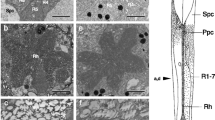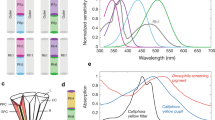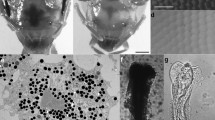Summary
Previous electroretinographic (ERG) studies of white-eyed and red-eyed (wild-type)Drosophila melanogaster (Stark and Wasserman, 1972a) yielded results that were in agreement with Goldsmith's (1965) hypothesis that eye-color pigment absorption decreases the recruitment of contributions from peripheral ommatidia into the ERG. These screening pigments therefore produce wavelength-specific differences between these two strains (as well as within the red-eyed strain) in three ERG parameters, namely the magnitudes of the on- and off-transients and the slopes of the receptor potential energy-response functions. In the present study these three ERG parameters were each measured for constant receptor potential magnitudes (to remove the contribution of spectral sensitivityper se) at 13 wavelengths from 350 nm to 650 nm in the following strains:cn (having only pterins),bw (having only ommatins), wild (having both pigment classes), and two white-eyed strains,cn bw andw. Multiple linear regression analyses were carried out in order to determine the relationships between the foregoing three ERG parameters and parameters related to spectral sensitivity. These data lead us to the following conclusions:
-
1.
Unexpected wavelength-dependent parameter differences exist in white-eyed flies. The slopes of the energy-response functions and the magnitudes of the transients all systematically vary and all correlate highly with the spectral sensitivity and with each other. This result implicates another spectrally selective factor other than pigment-determined recruitment in the ERG ofDrosophila. Several hypotheses about the nature of this factor are discussed.
-
2.
Parameter differences attributable strictly to eye-color pigments were found when wild,cn, andbw strains were compared with white-eyed strains. These parameter differences varied linearly with screening pigment density, and multiple linear regression analyses accurately predicted the differences in spectral sensitivity produced by the eye-color pigments from the parameter differences of transient sizes and energy-response function slopes.
Similar content being viewed by others
References
Adolph, A. R.: Thermal and spectral sensitivities of discrete slow potentials inLimulus eye. J. gen. Physiol.52, 584–599 (1968)
Alawi, A. A., Pak, W. L.: On-transient of insect electroretinogram: its cellular origin. Science (N.Y.)172, 1055–1057 (1971)
Autrum, H.: Electrophysiological analysis of the visual system in insects. Exp. Cell Res.5, 426–439 (1958)
Autrum, H., Zettler, F., Järvilehto, M.: Postsynaptic potentials from a single monopolar neuron of the ganglion opticum I of the blowflyCalliphora. Z. vergl. Physiol.70, 414–424 (1970)
Chappell, R. L., DeVoe, R. D.: Chromatic adaptation in the visible but not in the UV revealed in intracellular recordings from dragonfly ocellar receptors. In: The Association for Research in Vision and Ophthalmology Program,47 (1973). (Abstract)
Draper, N. R., Smith, H.: Applied regression analysis. New York: Wiley 1966
Eckert, H.: Die spektrale Empfindlichkeit des Komplexauges vonMusca (Bestimmung aus Messungen der optomotorischen Reaktion). Kybernetik9, 145–156 (1971)
Eguchi, E.: Fine structure and spectral sensitivities of retinular cells in the dorsal sector of compound eyes in the dragonflyAeschna. Z. vergl. Physiol.71, 201–218 (1971)
Ephrussi, B., Herold, J. L.: Studies of eye pigments ofDrosophila I. Methods of extraction—quantitative estimation of the pigment components. Genetics29, 148–175 (1944)
Goldsmith, T. H.: Do flies have a red receptor? J. gen. Physiol.49, 265–287 (1965)
Goldstein, E. B., Williams, T. P.: Calculated effects of “screening pigments.” Vision Res.6, 39–50 (1966)
Heisenberg, M.: Separation of receptor and lamina potentials in the electroretinogram of normal and mutantDrosophila. J. exp. Biol.55, 85–100 (1971)
Hotta, Y., Benzer, S.: Abnormal electroretinograms in visual mutants ofDrosophila. Nature (Lond.)222, 354–356 (1969)
Järvilehto, M., Zettler, F.: Electrophysiological-histological studies on some functional properties of visual cells and second order neurons of an insect retina. Z. Zellforsch.136, 291–306 (1973)
Lindsley, D. L., Grell, E. H.: Genetic variations of Drosophila melanogaster. Oak Ridge, Tennessee: Oak Ridge National Laboratory, 1967
McCann, G., Arnett, D.: Spectral and polarization sensitivity of the Dipteran visual system. J. gen. Physiol.59, 534–558 (1972)
Myers, J. L.: Fundamentals of experimental design. Boston: Allyn and Bacon 1966
Naka, K. I., Rushton, W. A. H.: An attempt to analyze colour reception by electrophysiology. J. Physiol. (Lond.)185, 556–586 (1966)
Stark, W. S.: The effect of eye colour pigments on the action spectrum ofDrosophila. J. Insect Physiol.19, 999–1006 (1973)
Stark, W. S., Wasserman, G. S.: Transient and receptor potentials in the electroretinogram ofDrosophila. Vision Res.12, 1771–1775 (1972 a)
Stark, W. S., Wasserman, G. S.: Temporal properties of the ERG on-transient recorded in the retina and lamina. Drosophila Inf. Serv.49, 63 (1972 b)
Stark, W. S., Wasserman, G. S.: Parametric analysis of the ERG in eye color mutants ofDrosophila. In: Proc. XIII Int. Cong. Genetics. Genetics74, s265 (1973) (Abstract)
Strother, G. K., Superdock, D. A.:In situ absorption spectra ofDrosophila melanogaster visual screening pigments. Vision Res.12, 1545–1547 (1972)
Snyder, A. W., Pask, C.: A theory for changes in spectral sensitivity induced by off axis light. J. comp. Physiol.79, 423–427 (1972)
Ziegler, I.: Genetic aspects of ommochrome and pterin pigments. Advanc. Genet.10, 349–403 (1961)
Author information
Authors and Affiliations
Additional information
We would like to thank Dr. Clifford Gillman for advice on statistics, Dr. Seymour Abrahamson for advice on genetics, and Mr. Charles Hodulik for assistance with the data. Supported in part by grants to Gerald Wasserman from the National Science Foundation (GB-8581) and from the Wisconsin Alumni Research Foundation. Additional support was provided by an NSF Predoctoral Fellowship awarded to William Stark; computer time was provided by the University of Wisconsin Graduate Research Committee.
Rights and permissions
About this article
Cite this article
Stark, W.S., Wasserman, G.S. Wavelength-specific ERG characteristics of pigmented- and white-eyed strains ofDrosophila . J. Comp. Physiol. 91, 427–441 (1974). https://doi.org/10.1007/BF00694472
Received:
Issue Date:
DOI: https://doi.org/10.1007/BF00694472




